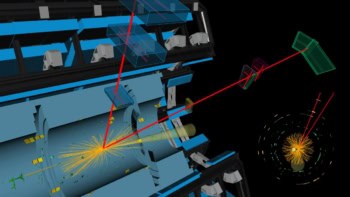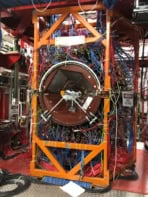If disappointments continue at the high-energy frontier, you might be hearing a lot more about the sterile neutrino, says Jon Cartwright

The list is long of unsolved problems in physics. Still, if you surveyed a number of people in the discipline they would probably agree on a few choices. There would be the question of why neutrinos have a small but significant mass, contradicting the zero mass specified by the current Standard Model of particle physics. Their lists would also include the nature of dark matter, that elusive substance that is thought to make up more than four-fifths of all matter in the universe. And there would probably also be a mention of why the universe is here at all – that is, why all the matter we see today was not annihilated by an equal amount of antimatter shortly after the Big Bang.
What if just one type of particle could solve all these problems? The idea may sound too simple to be true, but it is exactly the possibility raised by the sterile neutrino. A hypothetical particle that does not interact via any of nature’s four known forces except gravity, the sterile neutrino would be the universe’s most ghostly entity. Yet its effects would be very real: it could solve three of the biggest mysteries in physics, and maybe others besides.
Sterile neutrinos are not a new proposition – their theoretical history dates back to the 1970s – but until recently they have been only of niche interest. That is because for a long time the main driving force of particle physics has been pushing the “energy frontier” – the obvious example being the Large Hadron Collider (LHC) at the European lab CERN, which has been trying to crack open nature’s secrets with ever-stronger collisions. Once the LHC started to collect data in 2010, many physicists were expecting to be flooded with a torrent of new particles, particularly those given by supersymmetry – a popular theory that aims to solve many problems in physics by partnering the currently known elementary particles with a host of meatier “sparticles”. But when the LHC’s floodgates were opened, the river was dry: no new physics has been found.
With hopes for evidence of supersymmetry waning, lesser-studied topics such as sterile neutrinos are beginning to garner more attention. But disappointments at the high-energy frontier have not been the only prompt for a change in fashion. In the past few years, strong new evidence for sterile neutrinos has been found in nuclear reactors, bolstering the existing evidence from particle accelerators and radioactive sources. And, earlier this year, astrophysicists examining data from X-ray telescopes uncovered the first tentative evidence of sterile-neutrino dark matter in the distant cosmos. Emboldened by such results, many researchers are beginning to think the long-awaited breakthrough in particle physics may come not in a slew of different types of particle, but just one.
The long-awaited breakthrough in particle physics may come not in a slew of different particles but just one
“If we found a sterile neutrino, it would be the first time we were totally outside the Standard Model,” says experimental physicist Roxanne Guenette at the University of Oxford in the UK. “It would be a small extension, but with implications as important as discovering supersymmetry.”
Back to normality
The theoretical motivation for sterile neutrinos owes a lot to studies of normal neutrinos, which are sometimes called “active neutrinos” by comparison. These particles are themselves rather ghostly, interacting via only gravity and the weak force, and not via nature’s other two known forces, the strong and the electromagnetic. They were first proposed in the 1930s by the Austrian theorist Wolfgang Pauli to account for missing energy in nuclear decay, and were discovered about two decades later by experimental physicists including the Americans Clyde Cowan and Frederick Reines, the latter of whom won the 1995 Nobel Prize for Physics for the work. We now know that active neutrinos come in three types or “flavours”, one for each charged lepton: the electron neutrino, the muon neutrino and the tau neutrino (each with an associated antiparticle).
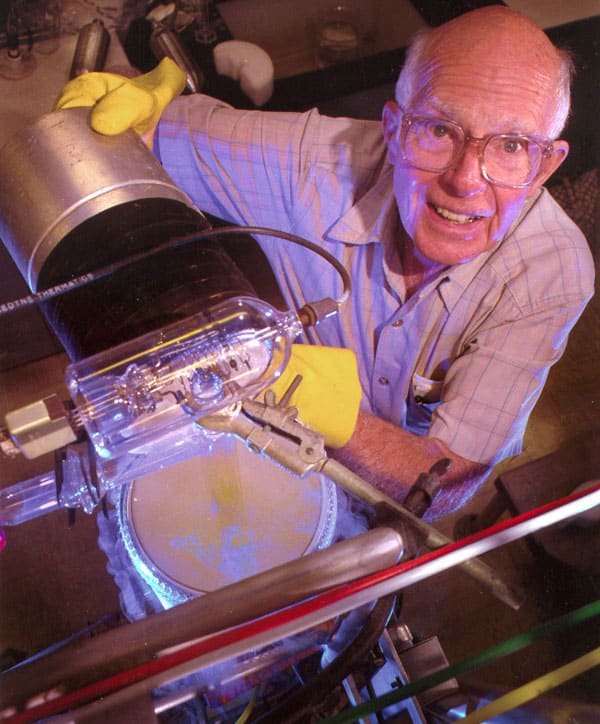
According to the original Standard Model, these three neutrinos were supposed to be massless, but that criterion soon began to crumble. In 1968 a team led by Ray Davis at the Brookhaven National Laboratory in the US found that it could detect only about a third of the electron neutrinos predicted to be arriving at its detector from fusion processes in the Sun, a result that was confirmed 20 years later by the Kamiokande experiment in Japan. Then, in 1998, a larger version of Kamiokande called SuperKamiokande, or SuperK, confirmed another strange result, this time about neutrinos generated in the atmosphere by cosmic rays. Theoretical models had predicted that there ought to be twice as many muon neutrinos generated by cosmic rays as electron neutrinos – but the researchers found roughly equal numbers of each.
Together, these solar and atmospheric anomalies – which led to Nobel prizes in 2002 for Davis and for Masatoshi Koshiba of SuperK – demonstrated that neutrinos must change flavour or “oscillate” as they travel. In Davis’s experiment the detector was sensitive only to electron neutrinos, and had therefore been oblivious to those that had oscillated into muon or tau neutrinos en route from the Sun. Meanwhile, oscillations taking place between the atmosphere and ground level had skewed the precise ratio of muon-to-electron neutrinos that the SuperK researchers had expected.
The fact that neutrinos oscillate suggested that they had mass, for if they didn’t, they would travel at the speed of light, and would not experience any time in which to oscillate. More specifically, though, the oscillations suggested that the three flavour states of neutrinos – electron, muon and tau – were actually mixtures of three distinct mass states. A neutrino in a pure flavour state contains a certain ratio of these three mass states, but during propagation these get out of step with one another. After a distance, the ratio of the mass states can become so distorted that, upon detection, the neutrino manifests as a different flavour altogether; what was once a muon neutrino might instead appear as an electron neutrino; and so on.
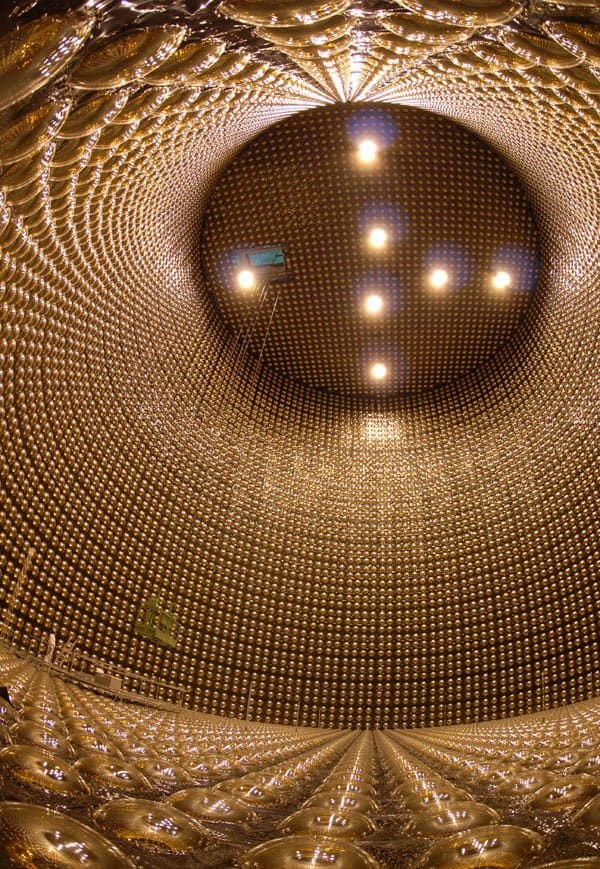
Although oscillations imply mass, particle physicists struggle to directly measure the individual masses of active neutrinos because the masses are so small; instead, they have access only to the difference between squared masses – specifically, the difference between the first and second squared-mass states, Δm122, and the difference between the second and third squared-mass states, Δm232. These parameters can be calculated by studying neutrinos that have been generated in particle accelerators or nuclear reactors and then have travelled great distances, typically hundreds or thousands of kilometres. The energy of neutrinos, E, and the distance over which they oscillate, L, are the two most important parameters for calculating the squared-mass differences, because the probability of oscillation is a function of both Δm2 and L/E.
Currently Δm122 looks to be about 7 × 10–5 eV2, while Δm232 looks to be about 2.3 × 10–3 eV2, making active neutrinos more than a million times lighter than the next lightest particle, the electron. In 1996, however, physicists working on the Liquid Scintillator Neutrino Detector (LSND) experiment at the Los Alamos National Laboratory in the US found a considerable proportion of electron antineutrinos in a beam of muon antineutrinos generated in an accelerator just 30 m away. The neutrino energy and oscillation distance suggested the existence of a mass-squared difference of around 1 eV2 – far greater than either Δm122 or Δm232, which alone are sufficient to define the three known neutrinos.
If the mass-squared difference given by the LSND was real, it suggested the existence of a fourth type of neutrino. But if there were a fourth neutrino, it could not be ordinary: experiments at CERN had already shown that there could be only three neutrinos coupling to the weak force in this mass range. In other words, the fourth neutrino, if it exists, must be largely immune, or “sterile”, to the weak force: it could interact only via gravity.
Breaking the model
If neutrino oscillations were troublesome enough for the Standard Model, the existence of a sterile neutrino would be its downfall. Since the Standard Model’s formulation in the late 1960s, no new particles have been found outside it; the Higgs boson, discovered in 2012 at the LHC, was considered to be the final piece of the Standard Model jigsaw.
If neutrino oscillations were troublesome enough for the Standard Model, the existence of a sterile neutrino would be its downfall
Still, the LSND’s result was not accepted outright, and other physicists set out to check it. At the beginning of this century, researchers at the Mini Booster Neutrino Experiment (MiniBooNE) – a detector at Fermilab in the US consisting of 720 tonnes of mineral oil lined with more than a thousand photomultiplier tubes – examined a beam of muon neutrinos arriving from a source 500 m away. The result, announced in 2007, was null: unlike the LSND result, no oscillations were found for the 1 eV2 mass-squared difference. But many physicists believed that could be because MiniBooNE was using neutrinos, not antineutrinos, and was therefore not a proper comparison. Three years later, the MiniBooNE team had repeated the experiment using antineutrinos and had a new result: a spike in electron antineutrinos – and support for the LSND’s finding.
“When one experiment gives an extremely unexpected result, people are very sceptical,” says Guenette, who is working on the successor to the MiniBooNE experiment. “People thought [the LSND result] was more likely a problem with the detector. So when the MiniBooNE result came out, everybody said ‘Hmm’. It was unlikely to be a detector problem, because both detectors were different.”
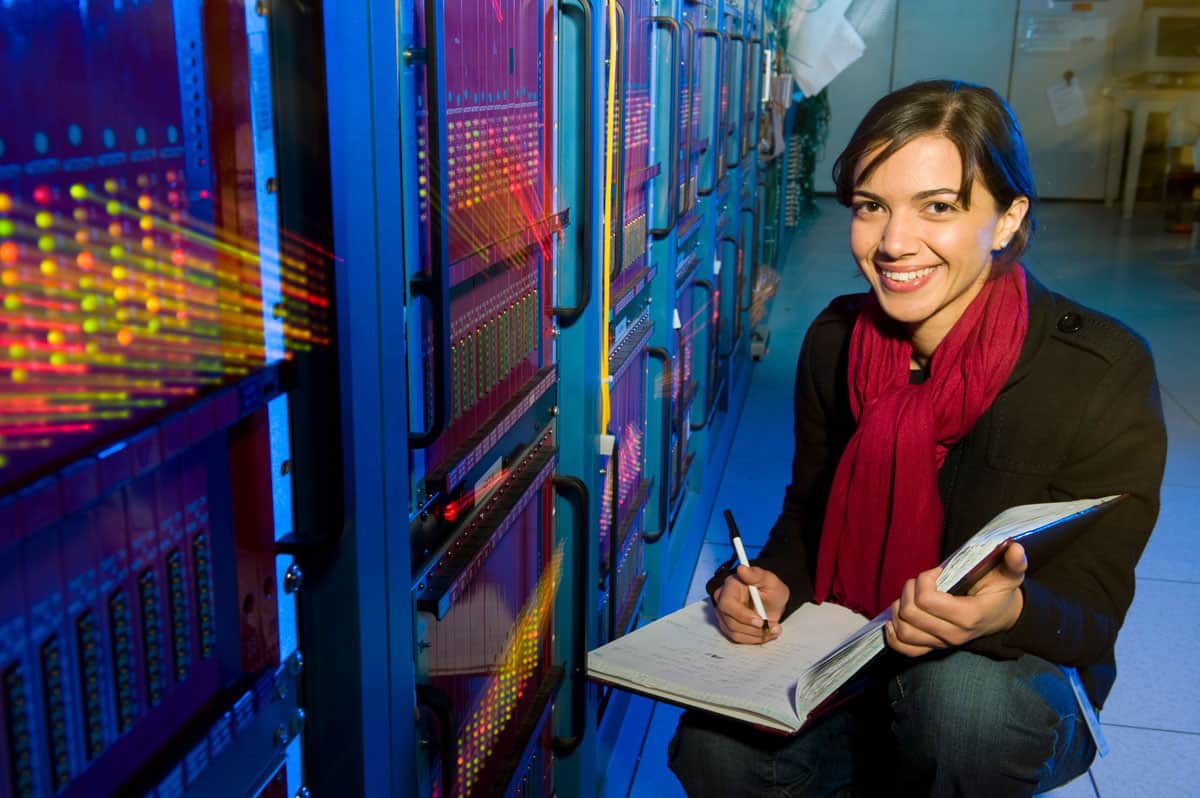
In the year after the MiniBooNE confirmation, support for the sterile neutrino was bolstered from a very different set of sources: nuclear reactors. Inside reactors, nuclear fission generates various neutron-rich nuclei that subsequently beta-decay into lighter nuclei. Beta decay always involves the emission of an electron or antielectron (positron), and almost always involves the emission of an electron neutrino or antineutrino.
In 2011 David Lhuillier at the Alternative Energies and Atomic Energy Commission in Saclay, France, and colleagues re-evaluated the number of electron antineutrinos that nuclear reactors ought to have been emitting over the past 30 years, and found that, between 10 and 100 metres from the reactors, they were coming up about 6% short. At this proximity, and with the energies involved, the electron antineutrinos were unlikely to be oscillating into any of the known active neutrinos, so the most obvious explanation was that some of them were oscillating into a fourth, more massive neutrino.
Perhaps the reactor evidence for sterile neutrinos should not have been surprising. Beginning in 1995, the solar neutrino experiments GALLEX at the Gran Sasso National Laboratory in Italy and SAGE at the Baksan Neutrino Observatory in Russia used known radioactive sources – chromium-51 and argon-37, both of which undergo “inverse” beta decay – for detector calibration. Again, the experimentalists had found a deficit in the expected count rate of electron neutrinos, this time of 5–20%. Nonetheless, it has been Lhuillier and colleagues’ more recent analysis of nuclear reactors that has really made people take notice of sterile neutrinos.
“Our work on the prediction of neutrino flux was initially completely disconnected from this topic,” says Lhuillier. “Today we still don’t know if sterile neutrinos exist or not, but our work triggered new interest.”
In February this year, evidence for sterile neutrinos went extraterrestrial. Searching through data from the European Space Agency’s XMM-Newton space telescope and NASA’s Chandra X-ray telescope, two independent groups – Esra Bulbul at the Harvard-Smithsonian Center for Astrophysics in the US and colleagues, and Alexey Boyarsky at Leiden University in the Netherlands and colleagues – found an excess of X-rays at about 3.5 keV. The researchers are cautious in drawing firm conclusions, but again there is an obvious explanation: the decay of dark matter in the distant cosmos. Being invisible, yet still interacting with gravity, sterile neutrinos would be an ideal candidate for dark matter, and 3.5 keV is about the energy of the X-rays into which they are expected to decay.
Front-page news
Solving the mystery of dark matter would be a major breakthrough in physics – one that would certainly make the front page of newspapers worldwide. But sterile neutrinos could solve several other mysteries, too. One of these is why the universe today is composed largely of matter and not antimatter: the Big Bang ought to have generated equal amounts of each, so the fact that they did not annihilate each other entirely – and that the universe as we know it exists at all – suggests that matter somehow managed to win over.
Many particle physicists believe the dominance of matter is a result of a phenomenon known as charge–parity (CP) violation. Preservation of CP is a technical way of saying that antiparticles interact in exactly the same way as their particle counterparts, albeit in mirror-reverse. In the Standard Model, CP is enforced by a symmetry in the theory that underpins particle interactions. But no such symmetry exists in the blueprint for sterile neutrinos, which means that when they decay they could more readily produce matter than antimatter. Perhaps, in the early universe, a decay of sterile neutrinos en masse laid the foundations for the matter-based planets, stars and galaxies we see today.
Then there are the neutrino masses themselves. These cannot be explained easily by the Higgs, which gives the masses of many other particles in the Standard Model, because the neutrinos would have to couple to it in an oddly weak manner. However, their masses could be explained with the so-called seesaw mechanism. The details of this are complex, but the idea is that heavy sterile neutrinos would “mix” with the known active neutrinos, lifting their masses slightly above zero. In fact, the seesaw mechanism, which was developed by the Swiss theoretical physicist Peter Minkowski and others in the 1970s, provided the first theoretical basis for sterile neutrinos.
Dark matter, CP violation, neutrino masses – at a glance you might wonder why the sterile neutrino has not always been a target for experimental particle physics. The reason probably lies in the nature of the sterile neutrino itself. While the results from terrestrial accelerator, reactor and radioactive-source experiments are mostly compatible with a mass-squared difference of about 1 eV2, dark matter would need a mass-squared difference of the order of 1 keV2, and CP violation would need a mass-squared difference of 100 GeV2 or more. Somewhat frustratingly, the original solar and atmospheric active-neutrino oscillations give no hint of what the masses of the sterile-neutrino should be. “Their mass can be anything – from 0.05 eV to 1015 GeV,” says Oleg Ruchayskiy, a particle physicist at the Swiss Federal Institute of Technology in Lausanne. “Really anything.”
One might think the simplest solution to three mysteries would be the existence of three sterile neutrinos – one to account for the oscillations seen in the LSND and other terrestrial experiments (with a mass of ~1 eV), one to account for dark matter (~1 keV) and one to account for the dominance of matter via CP violation (~100 GeV). To be sure, the existence of three sterile neutrinos would neatly mirror the known existence of three active neutrinos. But it turns out that even this scenario is problematic, because CP violation alone actually requires the existence of two sterile neutrinos with masses of around 100 GeV – meaning that if sterile neutrinos are to solve all the mysteries, there must be more than three of them. Partly for that reason, cosmologists often ignore the oscillations seen in the LSND and elsewhere and see sterile neutrinos only as a solution to dark matter and CP violation; for this scenario, they turn to a model known as the neutrino minimal standard model, which contains the three sterile neutrinos necessary for that purpose. If theorists do want to clear up the terrestrial oscillation results as well, they will have to turn to a heftier Grand Unified Theory, which can contain four – or indeed many more – sterile neutrinos.
Sterile neutrinos may not be as simple a solution to the biggest mysteries as they might at first seem
So, sterile neutrinos may not be as simple a solution to the biggest mysteries as they might at first seem. Still, there appears to be a growing desire among particle physicists to find out, once and for all, whether they exist.
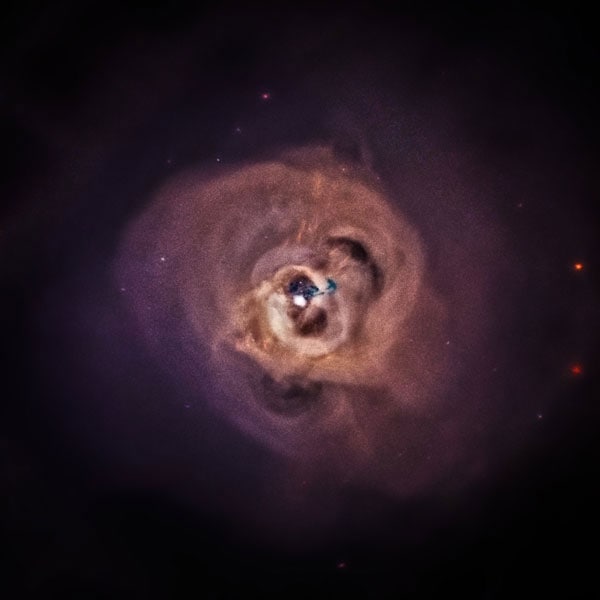
For sterile neutrinos at dark-matter masses (those at kilo-electronvolt scales), X-ray telescopes such as XMM-Newton, Chandra and the Japan Aerospace Exploration Agency’s Suzaku could provide more data that will settle the question. Although these cannot provide direct evidence for sterile neutrinos, a signal that varies correctly in proportion to the source – that is, more X-rays emanating from galaxy clusters than from emptier regions of space – would be strong evidence in favour of sterile-neutrino dark matter.
Meanwhile, studies of the cosmic microwave background (CMB) – the oldest light in the universe – can provide constraints on how light a sterile neutrino could be. Any particle with a very small mass can travel at relativistic speeds – that is, close to that of light – enabling it to transport energy quickly from one region of space to another. In the early universe, this process was crucial for the formation of the first cosmic structures, and it turns out that measurements of the CMB can place limits on the masses of each of the relativistic particle species added together. According to ESA’s Planck satellite, this figure is about 0.2 eV, which goes against the existence of a 1 eV sterile neutrino.
But there is another cosmological parameter that might yet go in favour of a new particle. In conjunction with certain other measurements, measurements of the CMB can provide an estimate of the total number of relativistic neutrino species in the early universe, neff. A few years ago this parameter was calculated to be about 4; after the latest analysis from Planck, neff came down to about 3.3. Given its uncertainty of ±0.3, the result is now compatible with three light neutrinos, but optimists see room for hope. “It seems to want to be a value greater than three,” says Jon Link, an experimental neutrino physicist at Virginia Tech in the US.
Well grounded
The most concerted effort to find sterile neutrinos, however, is back on Earth. A white paper authored by sterile-neutrino specialists in 2012 lists more than 20 proposed experiments to search for the particles. These range from accelerator to reactor and radioactive-source experiments; from experiments that search for electron-neutrino disappearance to those that search for muon-neutrino disappearance or muon-to-electron neutrino transitions. But, “realistically, only five or so of these will be pursued, and maybe only two funded”, says Guenette.
Guenette is working on one of those that is being funded – a successor to MiniBooNE, called MicroBooNE. A 150 tonne tank of liquid argon, MicroBooNE ought to be able to rule out the main concern about MiniBooNE’s 2010 result: that the detectors mistook photons – a very normal feature of background noise – for electron antineutrinos. That is because argon is less sensitive to a photon background than the mineral oil used in MiniBooNE.
Commissioning for MicroBooNE begins this autumn, and Guenette expects the data analysis to take three years. True, more evidence for a 1 eV sterile neutrino will not necessarily solve any cosmological mysteries. But Guenette believes a discovery would make the concept of heavier sterile neutrinos more palatable.
Joachim Kopp, a theorist at the Max Planck Institute for Nuclear Physics in Heidelberg, Germany, agrees. “There is no scientific argument for why a sterile neutrino at electronvolt scales would imply the existence of others,” he says. “But I would say it would make theorists more comfortable about the idea.”


